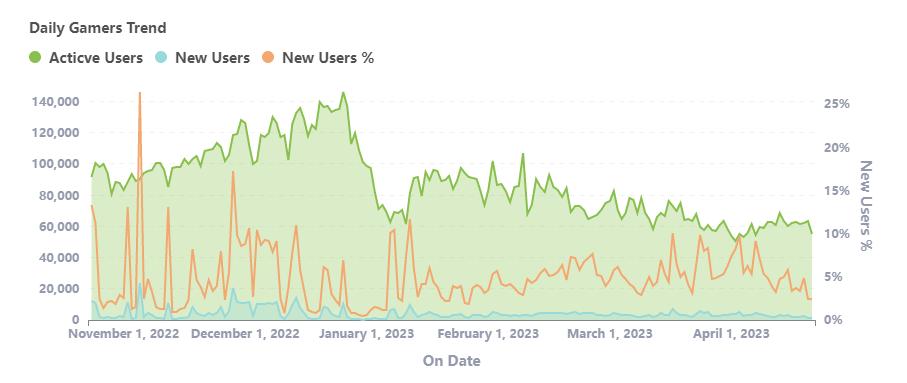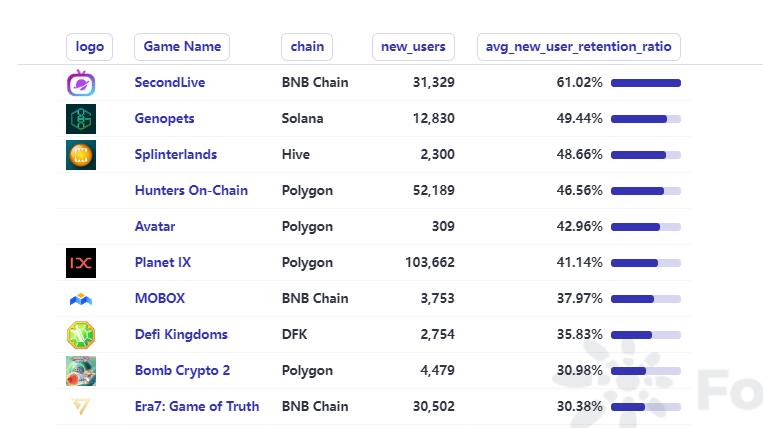Challenges and Opportunities of User Retention in Web3 Games: Starting from Economic Models and Game Design
Retention in Web3 Games: Balancing Economics and DesignAuthor: [email protected]

Developing and operating Web3 games comes with many challenges, so effectively addressing these challenges is crucial to the success of the game. Some strategies include comprehensive testing before the official release and continuing to provide new gameplay and content to ensure a stable game economy.
In addition to the obstacles encountered in development and operation, this article also discusses other interesting topics such as airdrops in Web3 games, bot issues, token economy design, and game mechanism design. Understanding player needs, attracting new players, balancing interests, creating a complete game ecosystem, and supporting a thriving game community are extremely important.
- Building a customer-oriented technology stack centered on the wallet
- iZiSwap & Discrete Flow Model: Revealing the Future Trend of AMM
- NFT lending platform Astaria, co-founded by Sushi’s former CTO Joseph Delong, is officially launched to the public.
Token Design for Web3 Games in 2023: Prospects and Development Trends
 Daily Gamers Trend
Daily Gamers Trend
Web3 games offer many opportunities for innovative developers, and the success of projects such as Shrapnel, Axie Infinity, and Illuvium has proven this. However, in this rapidly developing ecosystem, developers need to pay attention to many key issues to ensure the success of their projects.
Most projects pre-release tokens and NFTs before the game is launched, which many developers and players see as the key to game success. However, developers should be cautious about pre-allocating too many tokens before the game is thoroughly tested and ready to be released. The correct approach is to continue providing new gameplay and content after the game is launched to maintain player interest and establish a stable economic system. Pre-maturely allocating too many tokens may lead to an unstable game ecosystem, which can undermine the sustainability of the game.
To avoid this situation, we should understand the concept of “the toy on the shelf”. This concept points out that pre-allocation of tokens and NFTs may attract interest and investment, but once the game is officially launched, these pre-releases become obsolete. To attract and retain players, developers need to offer new and exciting gameplay and content to establish a loyal and committed player base, helping the Web3 game ecosystem to continue to grow.
Airdrops are a common way to retain players in Web3 games, but players may only participate for the sake of earning money rather than contributing to the game’s ecosystem. In addition, using bots to automatically participate in multiple airdrops to obtain more rewards is also a problem. These negative behaviors weaken the game’s ecosystem, resulting in unstable and declining game asset values.
Actually, airdrops themselves do not necessarily have a negative effect, their effectiveness depends on whether they can attract the right group of players. In contrast, developers should create games that focus on gameplay and a robust economic system to attract players interested in game design and mechanics, rather than just being driven by potential investment returns.
Take World of Warcraft as an example, there is a system in the game where players upgrade from low-level materials to more valuable materials. Each material has a different value and can be sold in-game to obtain gold coins. This creates a small market where new players need low-level materials, while high-level players can sell materials they don’t need on the market. Therefore, developers should create a benign cycle of gameplay and economic systems that make players feel interesting and worth participating in, attracting players who are truly interested in game design, rather than just being driven by potential investment returns. Although airdrops can attract players, they should not be the main means of retaining players.
Retaining players through the design of Web3 games and their ecosystems
Game developers need to take some measures to enhance the value of airdropped tokens or other game assets. For example, they can introduce a limited number of game props or tasks that require players to invest time and effort to complete, to ensure the scarcity of props and the fun of the game. This helps increase the value of early investment and maintain the attractiveness of the game, while avoiding abuse of governance power. The key is to create a stable economic system that encourages player participation and activity, rather than just attracting players who pursue investment returns.
Scarcity of game props is crucial for maintaining high retention rates. Game developers can create scarcity in the game through various mechanisms. For example, skins in Counter-Strike: Global Offensive are very scarce items and can be sold at high prices due to limited supply. Similarly, the tasks in Legend of Mir 4 require players to spend time and effort to complete, making it difficult to use bots to upgrade their game levels. These factors help increase player participation, maintain the value of in-game items, and attract player interest and participation.

Top Weekly Retention GameFi Projects in 2023
In addition, effective token economy design in Web3 games is also the key to maximizing retention. The focus is on creating fun and immersive experiences for players, not just focusing on issues such as asset value. The game design of “Magic The Gathering” is very attractive, regularly releasing new content and providing different game modes to keep players interested.
The secret to everything is to create unique and attractive games that players can invest in for the long term.
Retain players by designing NFT-related mechanisms and gameplay for other digital assets
In Web3 games, NFTs should give players a certain power boost, but game balance should also be considered in the design. The example of Gala Games’ game “Town Star” shows that relying too much on NFTs to determine players’ strength in the game may give some players significant advantages while almost making it impossible for other players to win.
To maintain balance, we need to reasonably set the power boost of NFTs. In PVP (player versus player) and PVE (player versus environment) games, NFTs should give players a certain power boost, but cannot completely dominate the game for paying players. On the contrary, we should find a balance point between players that can encourage players to participate in the game and the community, and not make the game a pure pay-to-win mode.
To retain players in Web3 games, developers need to carefully design game mechanisms that can meet the needs of high-asset players and provide opportunities for other players to catch up. This can be achieved by providing high-quality content for high-asset players, while gradually balancing the strength of other players. It is also important to attract new players to challenge high-asset players, which requires a lot of investment in game promotion.
In summary, effective token economy design in Web3 games requires creating a complete game ecosystem, deep understanding of player needs, balancing advantages between different players, and attracting new players to join, building a prosperous community together. Game developers should focus on designing mechanisms that encourage player participation, including using tools such as NFTs, and carefully consider the interaction and relationship between players to promote a balanced and lasting gaming environment.
How to Prevent Users from Profiting with Bots

Web3 games commonly have problems with bots, with some games having four times as many bot users as actual daily transaction volume. However, many games do not exclude these bot accounts as they can use the number of bots to greatly increase their active user data.
To optimize the game, developers need to take measures against bot problems. One method is to link wallets with accounts, thereby establishing an association network to identify bots. If the game design requires frequent trading, developers can discover direct associations by transferring multiple accounts to one account, and then mark these accounts as belonging to the same entity to help accurately identify the number of real players.
Bots are often mistaken for ideal players because they log into the game and complete tasks every day. However, by observing transaction behavior, bots can be distinguished from real players, which can help create an attractive game ecology for real human players.
Changing Web3 Game Play to Retain Players
Changing the game play of Web3 games has its advantages and disadvantages. On the one hand, it can attract different types of players and increase retention rates; on the other hand, frequent changes to the game mechanism may lead to the loss of old players. Therefore, throughout the game design process, it is necessary to attract different types of players and fully consider the needs of more users when changing game play.
Different players like different game plays. Some people like to use powerful game characters to focus firepower on a rapid attack, while others like to use a large number of cheap characters to resist continuously. Some people like to use ranged attack strategies to fight against enemies. If the vast majority of players only participate in one type of game play, game designers can increase the attractiveness of other game plays by adjusting the game mechanism. They can also try to introduce more innovative game plays, such as changing the game mechanism to force players to try new strategies. However, it is important to avoid overly coercive changes to avoid player loss.
In order to retain players with diverse interests, game developers must fully understand players of different ages, professions, analytical abilities, and game levels when changing game play. Game developers need to carefully analyze the current game design architecture and determine the features or content that need to be added to optimize the game experience for different players. In the process of optimizing the game, developers also need to consider many factors, such as style selection, single-handed or double-handed operation, and so on. When changing game play, game developers should strive to balance different needs, learn from successful cases, try new game plays, but also avoid excessive changes to avoid losing loyal users.
Changing the gameplay can indeed retain players, but it also comes with risks. On the one hand, game developers need to attract and retain different types of players throughout the entire game design. On the other hand, when changing the gameplay, the needs of different players need to be considered. “Clash Royale” is an example of a game that adds gameplay to attract different types of players.
If you want to attract different types of players to participate in the game by changing the gameplay, you need to know the following tips:
First, the game design should focus on attracting different types of players throughout the entire game. This can be achieved by providing diversified game content, features, and interactive mechanisms.
Second, when changing the gameplay, it is necessary to balance the needs of different players and avoid making one style of gameplay too powerful. Instead, different styles of gameplay should be optimized and balanced to ensure the diversity and balance of the game.
Third, encourage players to try new gameplay through daily challenges and other means, but also avoid being too forceful or overly pushed to avoid driving away old players. Maintain moderate guidance and balance, allowing players to choose new gameplay autonomously.
Finally, understanding the feedback of different players helps to achieve a balance between encouraging exploration of new gameplay and retaining existing players. This helps to understand the needs and expectations of players and make appropriate adjustments based on feedback to ensure the sustainability of the game and player satisfaction.
Web3 – A Tale of Power Returning to the Majority
The early stages of the Web3 ecosystem were initially developed by ordinary people who hoped to use decentralized and open on-chain systems to protect their assets. However, as Web3 became more popular, this technology gradually became adopted by the rich, and the big whales took control of the on-chain world from ordinary people. Finally, as the popularity of Web3 technology waned, the rich and celebrities became tired of it, and Web3 will begin to return to the hands of the majority of ordinary people.
At the current stage, it is important to develop value creation projects for ordinary people to promote the development of Web3 games and benefit more people. Ordinary developers must constantly try, learn, and improve their operational and development capabilities, truly understand user needs, and create value. Although failures may be encountered, as long as they persist in creating value for ordinary people, unexpected results will eventually be achieved.
At the beginning of a project, it is crucial to monitor the various types of assets entering the market, as this can lead to the loss of control over the project for most people. Projects that represent community interests are important in preventing this risk. Ordinary developers must have foresight and adaptability to contribute to the healthy development of Web3 games at this critical stage. By paying attention to industry developments, understanding the motivations and behaviors of various users, and planning for the next stage of development and operation, stable development of Web3 games can be achieved, ultimately returning to the hands of the majority.
Overall, the future of Web3 games depends on the dedication and innovation of ordinary developers who are committed to creating value for the majority. Through joint efforts, we can establish a more fair, transparent, and convenient on-chain environment that benefits everyone.
We will continue to update Blocking; if you have any questions or suggestions, please contact us!
Was this article helpful?
93 out of 132 found this helpful
Related articles
- Token Terminal: In-depth analysis of the operating principles and economic models of common Layer1
- Token Terminal: In-depth analysis of the operating principles and economic models of common Layer1s
- Rollups as a service solution: Eclipse technology principle analysis
- Origin Protocol: Dual-token model, a new player in the DeFi track
- Why does Vitalik believe that zk-SNARK technology will be as important as blockchain in the next 10 years?
- Understanding SAFT and Web3 Token Financing from the Perspective of Three-Generation Token Models
- Relation Protocol announces its native token REL economic model
